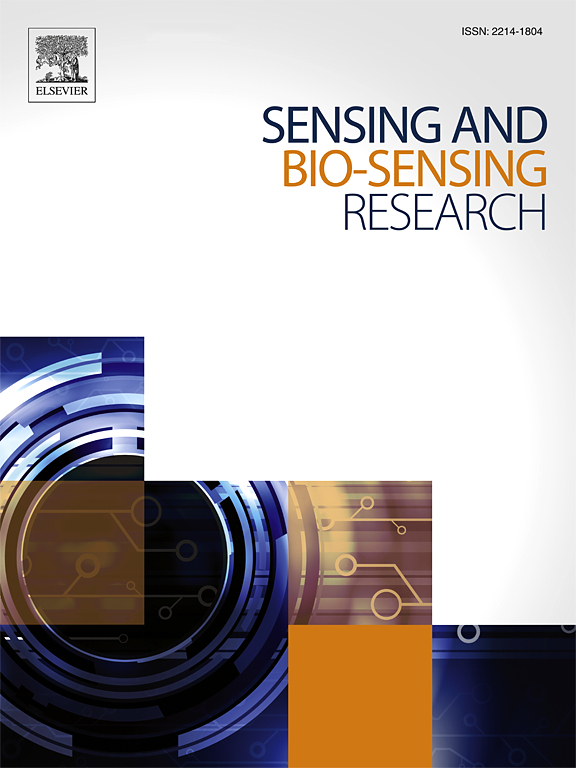壳聚糖修饰网印碳电极稳定硫化铜纳米颗粒/多壁碳纳米管复合材料的制备:对氧磷乙基的敏感性分析
IF 4.9
Q1 CHEMISTRY, ANALYTICAL
引用次数: 0
摘要
研制了一种基于油墨的纳米复合农药传感器,采用无酶电化学方法检测对氧磷乙基农药。农产品(如谷物、蔬菜和水果)受到乙基对氧磷污染,对人类健康产生不利影响。采用硫化铜纳米颗粒与多壁碳纳米管复合制备纳米复合油墨,壳聚糖作为粘合剂对对氧磷乙基传感器用丝网印刷碳电极进行改性。采用循环伏安法、电阻抗谱法和差分脉冲伏安法研究了所制备的印迹工作电极纳米复合墨水的性能。纳米复合材料(1:1:1)修饰电极具有良好的电化学性能,具有较高的活性表面积(2.15 cm2),低电荷转移电阻(355.59 Ω)和优异的电催化活性。该传感器在0.001-0.1 mM范围内对少量乙基对氧磷农药检测具有快速和高灵敏度。DPV技术在0.001 ~ 0.02 mM (R2 = 0.981)和0.025 ~ 0.1 mM (R2 = 0.935)范围内呈线性反应,检出限为0.0018 mM,定量限为0.005 mM。本文章由计算机程序翻译,如有差异,请以英文原文为准。
Fabrication composite of copper sulfide nanoparticles/multiwall carbon nanotubes stabilized by chitosan modified screen-printed carbon electrode: Sensitive analysis of the paraoxon ethyl
A nanocomposite ink-based pesticide sensor has been developed to detect a paraoxon ethyl pesticide using enzyme-less electrochemical processes. Paraoxon ethyl contamination on agricultural produce, e.g., grains, vegetables, and fruit, has adverse health effects on humans. Nanocomposite ink was synthesized using copper sulfide nanoparticles composited with multiwall carbon nanotube and using chitosan as a binder to modify the screen print carbon electrode for the paraoxon ethyl sensor. The performance of the proposed imprinted working electrode Nanocomposite ink was investigated using cyclic voltammetry, electrical impedance spectroscopy, and differential pulse voltammetry techniques. The nanocomposite (1:1:1) modified electrode illustrated good electrochemical performance, high active surface area (2.15 cm2), low charge transfer resistance (355.59 Ω), and excellent electro-catalytic activity. This sensor is rapid and highly sensitive for small amounts of paraoxon ethyl pesticide detection in the 0.001–0.1 mM range. The DPV techniques demonstrated two linear reactions ranging between 0.001 and 0.02 mM (R2 = 0.981) and 0.025 to 0.1 mM (R2 = 0.935) with a limit of detection of 0.0018 mM and a limit of quantitation of 0.005 mM, respectively.
求助全文
通过发布文献求助,成功后即可免费获取论文全文。
去求助
来源期刊

Sensing and Bio-Sensing Research
Engineering-Electrical and Electronic Engineering
CiteScore
10.70
自引率
3.80%
发文量
68
审稿时长
87 days
期刊介绍:
Sensing and Bio-Sensing Research is an open access journal dedicated to the research, design, development, and application of bio-sensing and sensing technologies. The editors will accept research papers, reviews, field trials, and validation studies that are of significant relevance. These submissions should describe new concepts, enhance understanding of the field, or offer insights into the practical application, manufacturing, and commercialization of bio-sensing and sensing technologies.
The journal covers a wide range of topics, including sensing principles and mechanisms, new materials development for transducers and recognition components, fabrication technology, and various types of sensors such as optical, electrochemical, mass-sensitive, gas, biosensors, and more. It also includes environmental, process control, and biomedical applications, signal processing, chemometrics, optoelectronic, mechanical, thermal, and magnetic sensors, as well as interface electronics. Additionally, it covers sensor systems and applications, µTAS (Micro Total Analysis Systems), development of solid-state devices for transducing physical signals, and analytical devices incorporating biological materials.
 求助内容:
求助内容: 应助结果提醒方式:
应助结果提醒方式:


